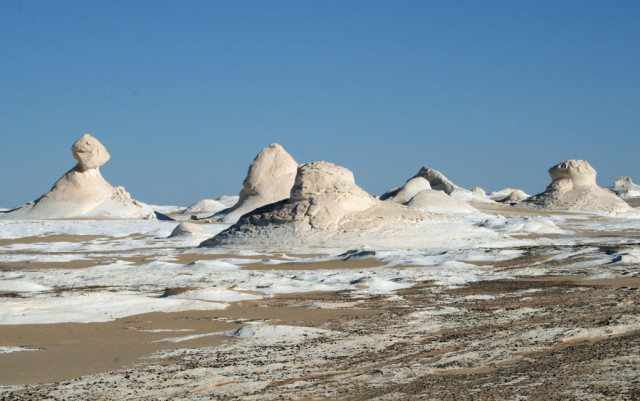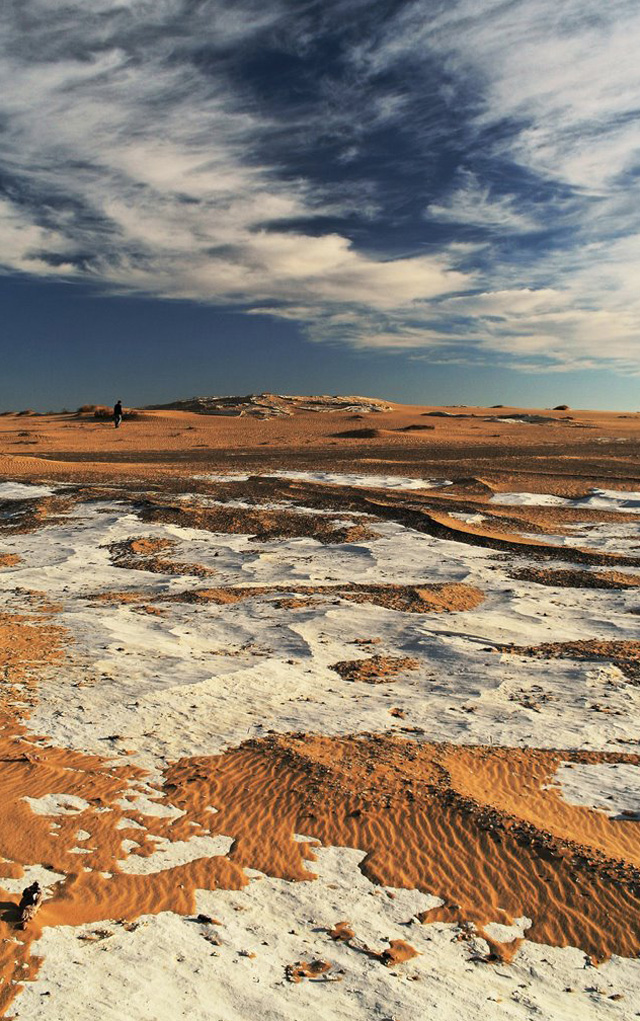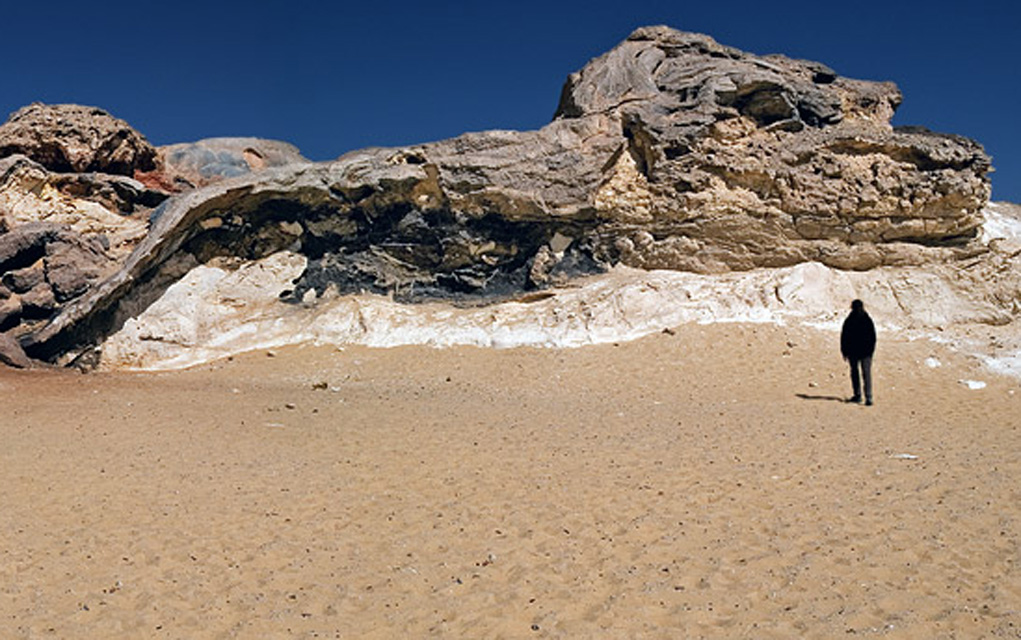
“Love is very simple,” says specialist desert guide Khaled Hafez as he lies back on a tightly woven Bedouin carpet and sips sweet black tea, surrounded by the White Desert. He rubs his chin slowly and says: “A Bedouin man draws the outline of his foot on a rock and shows it to the woman he desires. If she places her foot inside his, her answer is yes and there’s marriage. Deserts, on the other hand, are far more complicated. You can hate them one day and fall in love with them the next. Then they get under your skin, and then you have to keep coming back, like I do.”
Those with no interest in museums claim they are boring, and the uninspired say the same of deserts, along with “there’s nothing but sand to see.” This, only because they haven’t taken time to feel the desert, and most definitely have never seen the unspeakable beauty that is Egypt’s Black and White deserts.
Standing on the roof of the Land Cruiser, Bedouin driver Ali Ganawi ties down a crimson carpet and a short-legged table alongside jerry cans of fuel and water. “Yalla (let’s go),” he says, with a wide white smile to match his pure white robes and turban. Ali and Khaled are up front and I slip into the back seat for a magic carpet ride through Egypt’s great Western Desert; it incorporates the Black and White deserts, about half a dozen settled oases and thousands more square kilometers of Sahara.

The low-slung oasis town of Bahariyya is in the rearview mirror, along with Bedouin children in layered clothing playing joyfully along the roadside. Within minutes we are surrounded by silky sand rolling out in a creamy carpet in all directions. About 80 million years ago we would be driving on the sea floor; now we are in a sand sea with inky blue skies overhead. The Sahara, known as The Great Sand Sea, is an impressive 9 million square kilometers, roughly the size of the U.S., and stretches right across North Africa, coast to coast. It is also a place of extreme beauty and harshness, somewhere you never travel alone.
Ali was born in the oases of Bahariyya and has been driving these unmarked deserts for over 20 years. He laughs when I ask him if he’s ever been lost. “Lost?” he says, raising his eyebrows in dismay.
“You can’t get lost if you can see the sun or the stars.” He points to his head and says, “In here is a Bedouin compass.”
This desert has no landmarks, no apparent permanent features whatsoever. Even the sand dunes shift 6 kilometers a year, so the sky is the only map there is and a good “Bedouin compass.” With one hand on the wheel and the other animatedly explaining a story to Khaled in Arabic, Ali says desert driving relaxes him and the stillness brings him closer to himself. Life at home with six children can be hectic.
As we drive, the landscape takes on a scorched, sunburned look. The creamy sand is now black. When we stop and look closer, it’s not the sand that’s black but rather a covering of tiny smooth black pebbles that now camouflage the desert sand as far as you can see.
“It looks like a big hand in the sky scattered the pebbles across the desert,” Khaled says. “It’s really amazing.”
The black is dolomite, and in between lie boulders, which reveal flintstone when cracked open. The landscape is quite otherworldly, a little like landing on the moon without leaving earth.
A little further along, Ali pulls off the track and Khaled beckons me to follow him. “Come and look,” he says, motioning with his hand to follow him. “It’s the entrance to heaven.”
And there, in the sandscape stands a perfect arch of natural crystal, dazzling like a daytime disco in the midday sun. Crystal Mountain is not a mountain but an outcrop, and can easily be missed if you don’t know where to look. That’s the thing about deserts. Their treasures are not always obvious, but revealed only to those who take time to discover them.
“Are you hungry?” Ali asks, as he hoists himself back onto the roof of the vehicle. He passes Khaled the table and carpet and a cooler box. An instant Bedouin picnic materializes. A spread of flat bread, boiled eggs, fresh tomatoes and tahini is cool and delicious. In a heartbeat a small fire is burning too, for no meal is complete without at least three little glasses of sweet black tea. “It’s Bedouin whisky,” jokes Ali, while sipping glass after glass.
“Now prepare to be amazed,” Khaled says, as we continue on our way, swathed by sand in all directions. The desertscape slowly begins to transform again. Sand turns honey hued and white limestone formations like icy termite mounds start to emerge. We turn off the main desert track and drive deeper into this field of strange white sculptures, all carefully chiseled by wind and time. They rise as towers from the desert floor, and then a skull appears before us huge and ghostly — and then a sphinx and an eagle in static flight. Your imagination runs wild as this enchanted garden of sand and limestone, with giant mushrooms and fantastical stone creatures, slowly reveals itself for over 3,000 square kilometers. This is the White Desert, a playground for the mind. Khaled and Ali have been here countless times, but they say every time is like the first.

Ali stops the vehicle, and we get out and walk slowly amongst the astounding natural creations that resemble plants and animals, but have stood there for all time. It’s perfectly silent as the afternoon light dusts the desert in pastel pinks and blues. We set up camp for the night on the soft sand floor, with little need to speak. It seems intrusive in such quiet. The landscape is so surreal, so breathtakingly beautiful, you want to focus on soaking it into your soul so you don’t forget such places still exist on earth.
Then the moon rises, washing the White Desert in pure enchantment. We lie on our backs in the cushioning sand alongside the dancing fire, and stare heavenwards as a million bright stars pierce the night sky with light.
“Every time I come here, I fall in love,” Khaled says softly. “And just wait for the purple sunrise in the morning. It looks like you are on another planet. That’s why I keep coming back — the light here is natural magic.”
And then there is quiet as we fall asleep in the desert’s million-star hotel, without need for a bed.














